Afternoon
Ok, beginner here with limited experience. I have a pair of Dayton PS180-8 and a pair of RS225-8, looking for advice on how to best employ them. At one point I had the PS180's in a simple vented enclosure based of Dayton audio recommendations and they sounded descent. No low and a little harsh on top end. After reading some post I see a notch filter should help. Any ideas would help.
Real question is is it possible to make a fast system with them? or does it even make since. Looking for quality sound with good low end.
Dayton RS225-8 + the PS180-8?
Ok, beginner here with limited experience. I have a pair of Dayton PS180-8 and a pair of RS225-8, looking for advice on how to best employ them. At one point I had the PS180's in a simple vented enclosure based of Dayton audio recommendations and they sounded descent. No low and a little harsh on top end. After reading some post I see a notch filter should help. Any ideas would help.
Real question is is it possible to make a fast system with them? or does it even make since. Looking for quality sound with good low end.
Dayton RS225-8 + the PS180-8?
Sounds interesting.
PS180-8 seems to have a rising response.
Most the low end is at 95 dB then a lot of zing above 2k around 100 to 105 dB
So yes with baffle step compensation and a notch
the driver would sound much more balanced.
Everyone has opinions on what is " best"
The fullrange could just go in a well stuffed
large midrange chamber.
Then get better bass from the 8"
in a straight forward reflex.
Baffle width is going to be wide
enough for the 8"
So without elaborate cutting angles.
Fullrange could just be mounted offset
in upper corner for least diffraction.
All easily simulated, for crossover design.
Reducing bass from the fullrange.
Then compensation, would help clean it up.
PS180-8 seems to have a rising response.
Most the low end is at 95 dB then a lot of zing above 2k around 100 to 105 dB
So yes with baffle step compensation and a notch
the driver would sound much more balanced.
Everyone has opinions on what is " best"
The fullrange could just go in a well stuffed
large midrange chamber.
Then get better bass from the 8"
in a straight forward reflex.
Baffle width is going to be wide
enough for the 8"
So without elaborate cutting angles.
Fullrange could just be mounted offset
in upper corner for least diffraction.
All easily simulated, for crossover design.
Reducing bass from the fullrange.
Then compensation, would help clean it up.
Greets!Real question is is it possible to make a fast system with them? or does it even make since. Looking for quality sound with good low end.
Dayton RS225-8 + the PS180-8?
Sure! Though if no DSP, then ideally a tweeter would be added in lieu of frequency shaping filters. XO wherever the baffle step is.
Very much so
Tweeter would help a lot
The highend of the PS180 is pretty rough.
and off axis its a dead duck above 5K
I played with crossover in sim.
Once you smooth out the PS180
it will average around 94 dB
So adding in the 86 dB 8" woofer
requires a lot of padding to make it work.
Basically likely 180 dollars worth of crossover parts.
to get a response similar to many 8" fullrange speakers.
but poor sensitivity
I would just run the series notch on the fullrange
to balance the sound.
And call it a day.
Bass wont improve, but wont be hidden
by the 105 dB highend.
So bass actually will sound better
since the speaker is being balanced to
around 94 dB
Likely use the Reflex you already have
and smooth out the highend with the series notch.
easy and low cost with such a small inductor.
Tweeter would help a lot
The highend of the PS180 is pretty rough.
and off axis its a dead duck above 5K
I played with crossover in sim.
Once you smooth out the PS180
it will average around 94 dB
So adding in the 86 dB 8" woofer
requires a lot of padding to make it work.
Basically likely 180 dollars worth of crossover parts.
to get a response similar to many 8" fullrange speakers.
but poor sensitivity
I would just run the series notch on the fullrange
to balance the sound.
And call it a day.
Bass wont improve, but wont be hidden
by the 105 dB highend.
So bass actually will sound better
since the speaker is being balanced to
around 94 dB
Likely use the Reflex you already have
and smooth out the highend with the series notch.
easy and low cost with such a small inductor.
Last edited:
When I was looking at these Dayton drivers, I came across this post on PETT. I would think it would apply to the PS180 as they are basically the same driver
https://techtalk.parts-express.com/forum/tech-talk-forum/66754-how-to-train-your-pm180-8
https://techtalk.parts-express.com/forum/tech-talk-forum/66754-how-to-train-your-pm180-8
Thank you. I didn't even take the sensitivity gap. Still learning all this stuff. So follow up, when you say a lot of padding do you mean basically I'll have to almost smother the sound from 180 if an effort to decrease sensitivity to better match the 225?Very much so
Tweeter would help a lot
The highend of the PS180 is pretty rough.
and off axis its a dead duck above 5K
I played with crossover in sim.
Once you smooth out the PS180
it will average around 94 dB
So adding in the 86 dB 8" woofer
requires a lot of padding to make it work.
Basically likely 180 dollars worth of crossover parts.
to get a response similar to many 8" fullrange speakers.
but poor sensitivity
I would just run the series notch on the fullrange
to balance the sound.
And call it a day.
Bass wont improve, but wont be hidden
by the 105 dB highend.
So bass actually will sound better
since the speaker is being balanced to
around 94 dB
Likely use the Reflex you already have
and smooth out the highend with the series notch.
easy and low cost with such a small inductor.
Basically for a passive solution.
The 8" woofer is only 86 dB
So padding resistors are added to the fullrange to get a response match.
You would be padding around 8 dB.
Using a fullrange, then adding assistance for bass has been done.
Since you already have the woofers. just find a fullrange with a better sensitivity match.
Great thing is usually a 3" fullrange will be around 84 to 86 dB
and a small 3" has smoother top end.
So a good match for a 86 dB woofer.
All Dayton solution could be
RS75-T8 = 84 dB
PC83-8 = 85.6 dB
That would be a project for the 8" woofer.
Far as what you have currently.
The PS180 in a bass reflex.
The driver response and baffle step response
can be modeled. According to your current baffle size.
Then design a simple series notch to balance out the high end response.
The 8" woofer is only 86 dB
So padding resistors are added to the fullrange to get a response match.
You would be padding around 8 dB.
Using a fullrange, then adding assistance for bass has been done.
Since you already have the woofers. just find a fullrange with a better sensitivity match.
Great thing is usually a 3" fullrange will be around 84 to 86 dB
and a small 3" has smoother top end.
So a good match for a 86 dB woofer.
All Dayton solution could be
RS75-T8 = 84 dB
PC83-8 = 85.6 dB
That would be a project for the 8" woofer.
Far as what you have currently.
The PS180 in a bass reflex.
The driver response and baffle step response
can be modeled. According to your current baffle size.
Then design a simple series notch to balance out the high end response.
Fostex FF85wk, Mark Audio Alpai r5.2/3 (or CHN-50 on a budget) are my favorite 3”. The rumoured MAOP 5.3 is probalby a real gem.a 3" fullrange will be around 84 to 86 dB
ABout 86-87dB. Make really good midTweeters.
Here FF85wKeN used with a pair of Silverflute W14eN. Large choice of woofer impedance and series or parallel give a whole lot of sensitivity choices (2 4Ω in series here, no padding on the mT)
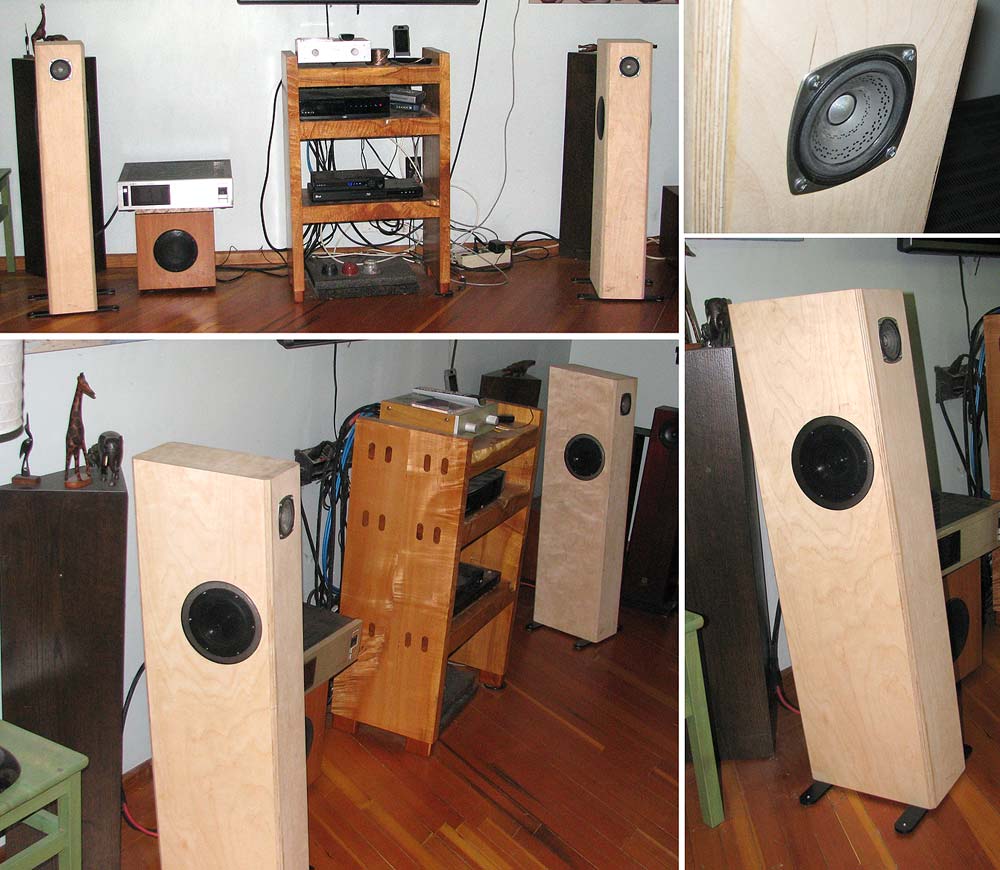
dave
If you are adding woofers below, the box i posted above would bnicely XO to a 4th orfer REL-style woofer at about 80 hz.
dave
dave
Oh yeah.
Perfect.
I'll be the first to admit.
Hearing with your eyes, can make accepting the side mounted woofer
a bit tough at first.
Once you accept the form factor and realize it maintains
a narrow baffle, and as a tower gives plenty of volume.
Great design.
after you model/measure the woofer response.
love it even more.
Perfect.
I'll be the first to admit.
Hearing with your eyes, can make accepting the side mounted woofer
a bit tough at first.
Once you accept the form factor and realize it maintains
a narrow baffle, and as a tower gives plenty of volume.
Great design.
after you model/measure the woofer response.
love it even more.
An ML-TL with F10 about 35 Hz anechoic. Pretty much omnidirectional up to above the 450 Hz (passive) XO.… as a tower gives plenty of volume.
dave
Thank you for the advice. I think your right with finding a smaller full range to match. I would probably spend just as much buying something as I would trying to get this to work. Thank youBasically for a passive solution.
The 8" woofer is only 86 dB
So padding resistors are added to the fullrange to get a response match.
You would be padding around 8 dB.
Using a fullrange, then adding assistance for bass has been done.
Since you already have the woofers. just find a fullrange with a better sensitivity match.
Great thing is usually a 3" fullrange will be around 84 to 86 dB
and a small 3" has smoother top end.
So a good match for a 86 dB woofer.
All Dayton solution could be
RS75-T8 = 84 dB
PC83-8 = 85.6 dB
That would be a project for the 8" woofer.
Far as what you have currently.
The PS180 in a bass reflex.
The driver response and baffle step response
can be modeled. According to your current baffle size.
Then design a simple series notch to balance out the high end response.
Thank youWhen I was looking at these Dayton drivers, I came across this post on PETT. I would think it would apply to the PS180 as they are basically the same driver
https://techtalk.parts-express.com/forum/tech-talk-forum/66754-how-to-train-your-pm180-8
That is exactly what I was thinking. As far as designHere FF85wKeN used with a pair of Silverflute W14eN. Large choice of woofer impedance and series or parallel give a whole lot of sensitivity choices (2 4Ω in series here, no padding on the mT)

Last edited by a moderator:
Thanks everyone! Great info I'm going to work through these and take that leap. Really digging the Karlsonator. Not something you see anywhere. Appreciate it.
You could double up on the 8" drivers and run them powered through a separate cabinet, but that's running deep into subwoofer territory. Doubling them only gives you +3 dB sensitivity, so you would need to add +5 more through power. In VCAD this is more like +8, estimated @8ohms. It would probably sound great, but have a limited overall volume. We're talking a fleawatt on the mains and ~200W into the bass section here.
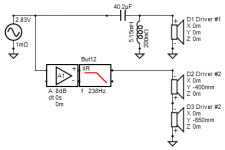
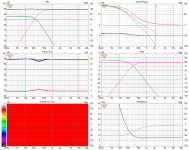
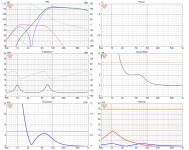
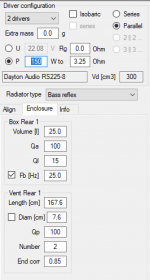
I only spent 5 minutes in VCAD so IDK really, but it doesn't seem like the best fit. I'd have gone for a PS95 or an RS100 if you want a simple passive setup. The 6.5" and 8" are really meant to stand alone, which I do not tend to like. Your instinct to go multi-way is wise and well-founded.
Consider making a point-source system with the 6.5" for nearfield use, and a more complex system with the RS225's. They are supposed to be stunning in a 3-way.




I only spent 5 minutes in VCAD so IDK really, but it doesn't seem like the best fit. I'd have gone for a PS95 or an RS100 if you want a simple passive setup. The 6.5" and 8" are really meant to stand alone, which I do not tend to like. Your instinct to go multi-way is wise and well-founded.
Consider making a point-source system with the 6.5" for nearfield use, and a more complex system with the RS225's. They are supposed to be stunning in a 3-way.
I think the stand alone for the 6.5 is the way to go also. Just to hard to match up good with anything. May due the fast/wav I see in the form for the 225 at a later date looks cool and I already have the ps95 on hand.You could double up on the 8" drivers and run them powered through a separate cabinet, but that's running deep into subwoofer territory. Doubling them only gives you +3 dB sensitivity, so you would need to add +5 more through power. In VCAD this is more like +8, estimated @8ohms. It would probably sound great, but have a limited overall volume. We're talking a fleawatt on the mains and ~200W into the bass section here.
View attachment 1071697View attachment 1071696View attachment 1071694
View attachment 1071695
I only spent 5 minutes in VCAD so IDK really, but it doesn't seem like the best fit. I'd have gone for a PS95 or an RS100 if you want a simple passive setup. The 6.5" and 8" are really meant to stand alone, which I do not tend to like. Your instinct to go multi-way is wise and well-founded.
Consider making a point-source system with the 6.5" for nearfield use, and a more complex system with the RS225's. They are supposed to be stunning in a 3-way.
- Home
- Loudspeakers
- Full Range
- Dayton PS180-8: what to do with them

